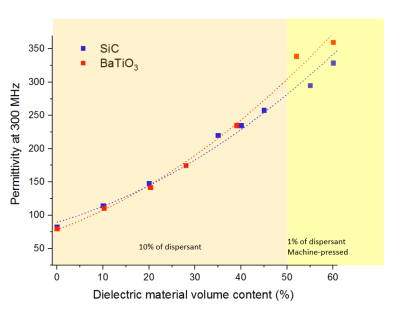2664
Evaluation of a new long-lasting Silicon Carbide based dielectric pad for ultra-high field MRI1CEA-Neurospin, Paris, France, 2Institut Fresnel, Marseille, France, 3Siemens Healthineers, Saint Denis, France, 4CEA-Le Ripault, Monts, France
Synopsis
A simple and efficient way to enhance the B1+ field dark areas appearing in the temporal lobes at 7T in MRI is to use pads with relative High-Dielectric Constant materials which most promising ones are perovskites mixed with water. As their performance drops over time, those materials are still not currently used in clinical routine. A novel high lifespan material made of 4-Fluoro 1.3-dioxalan-2-one and Polyethylene glycol mixed with silicon carbide particles is presented here. It is shown that their performances are on pair with BaTiO3 water mixture through permittivity measurements and MRI scans a 7T.
Introduction:
One way to address the B1+ inhomogeneity in ultra-high field MRI (B0≥7T) is the use of relative High-Dielectric Constant (HDC) materials in radiofrequency (RF) coils [1]. Their high displacement currents alter the global RF distribution in the transmit coil and generate a secondary localized RF field used to tune the B1+ field distribution. Most current effective HDCs are currently made into small rectangular pads filled with BaTiO3 water mixtures. Unfortunately, major drawbacks prevent their use in clinical routine: drops in performance over time [1] and toxicity during preparation [2]. A new dielectric material combined with an innovative solvent is presented here to mimic BaTiO3 pads performance while addressing those issues to pave the way for new long-lasting, comfortable and efficient pads.Materials and Methods:
Silicon Carbide (SiC) spherical particles (Neyco, Vanves, France) were mixed with 4-Fluoro 1.3-dioxalan-2-one (Chemos, Regenstauf, Germany), also called FEC, with powder volume ratio contents ranging from 5% to 60%. Particles average size is around 2 µm to ensure good particle density in the composite material. Volume contents of Polyethylene glycol (Sigma-Aldrich, Saint Louis, USA), also called PEG, is added as a dispersant agent for the slurry homogeneity. Its quantity is fixed to 10% for volume contents of SiC below 50% and to 1% above 50% to ensure high permittivity levels in the sample. Samples above 50% are machine-pressed. Its number average molar mass is 10 000. Permittivity measurements on the mixtures have been carried out through Nicolson and Ross protocol [3] combined with a de-embedding process using an innovative coaxial cell and sample holder [4]. Rectangular 10x10x1 cm3 pads in polylactic-acid were filled with those mixtures in order to compare their performance to BaTiO3 water pads. B1+ maps were carried on using XFL sequences [5] with and without pads, using a birdcage head coil 1Tx/1Rx (Invivo Corp., Gainesville, USA) and a 3-D printed Specific Anthropomorphic Mannequin phantom (SAM; ε’=42; ε’’=60) on a 7T Magnetom MRI scanner (Siemens Healthineer, Erlangen, Germany).Results:
Figure 1 shows permittivity levels reached by our composite materials at 300 MHz from 0 to 60% volume contents of SiC powder. Permittivity levels of BaTiO3 water mixtures are also presented (from [6]). The effects of one SiC pad (ε’=288, ε’’=80) is compared to one pad filled with BaTiO3 (ε’=241, ε’’=29) mixture. Its permittivity levels are chosen to have a similar effect to the BaTiO3 pad given permittivity. To that end, B1+ field distributions are displayed in Figure 2. In both case a B1+ illumination is observed and the dark area located in the left temporal lobe is tightened in the vicinity of the pad.Discussion:
Compared to BaTiO3, a pad filled with SiC particles exhibits a lower B1+ illumination owing to its higher conductivity. This is a consistent issue when using dispersant agents [1]. But its penetrating effect can be tuned by adjusting the pad permittivity from 100 to 300. Thus, this new HDC material displays the required permittivity range to be effective for MR imaging at 7T. It also has the potential for being daily used in clinical routines. First, it overcomes the main limitation of the current water based pads which is its decrease in performance over time [1]. Indeed, the combination of its solvent and dispersant agent allows a long lifespan: permittivity levels were preserved after 6 months. Since the solvent fusion temperature is close to 25°C, the mixture can be stored at lower temperature to prevent particles sedimentation. Pads are also less prone to dry out as the solvent boiling point is twice the water boiling temperature. Then, the overall pasty consistence allows the design of comfortable pads that are not likely to break and deform when used on a daily basis. Finally, toxicity threat is much lower than BaTiO3 powders which makes it easier, safer and faster to prepare.Acknowledgements
This work has been supported by the Programme Transversal du CEA and the FET-OPEN M-CUBE Project.References
[1] O’Reilly and al., Journal of Magnetic Resonance, 2016, 270, 108-114.
[2] Regulation EC 1272/2008.
[3] L. F. Chen and al., Microwave Electronics, John Wiley & Sons, 2004.
[4] É. Georget and al., Comptes Rendus Phys., 2014, 15(5), 448–457.
[5] S. Chung and al., Magnetic Resonance in Medicine, 2010, 64, 439–446.
[6] A. L. Neves and al., Magnetic Resonance in Medicine, 2017 (ahead of print).
Figures

